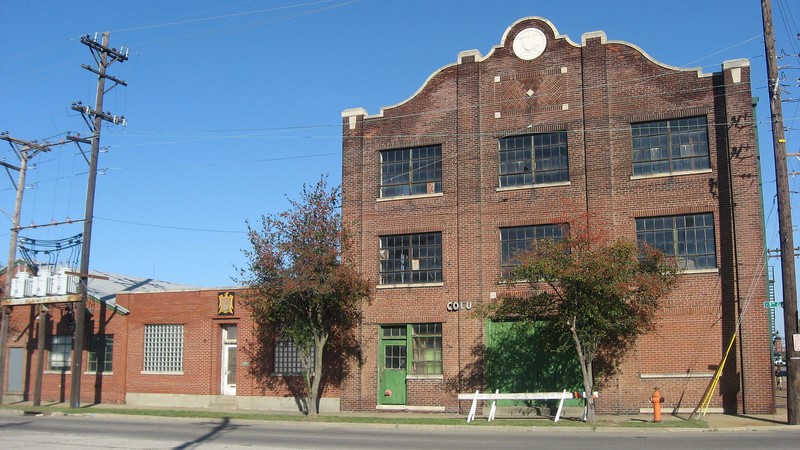The Harig, Koop, and Company - Columbia Mantel Company Building
Introduction
Text-to-speech Audio
Images
The Harig, Koop, and Company - Columbia Mantel Company Building

Backstory and Context
Text-to-speech Audio
The furniture manufacturing facility for Harig, Koop, and Company and then the Columbia Mantel Company opened in 1871 and remained in use for more than a century, Louisville's longest-serving furniture factory. Its presence serves as a physical reminder of the thriving furniture industry that first emerged during the 1860s and grew highly successful by the 1920 and 1930s when Louisville became a regional furniture manufacturing hub.
Louisville's first directory in 1832 listed less than twenty cabinetmakers and five chair makers, all small operations run by one or two artisans who built things by hand. By the late 1850s, larger operations emerged as mechanization began to assist furniture makers. Louisville's location along the Ohio River made it ideal for taking advantage of some mass production, which could be shipped to other markets. As such, by 1860, Louisville and vicinity supported fourteen furniture and cabinet operations employing 194 employees, and then by the 1870s and 1880s, larger-scale furniture production companies had ostensibly put small, hand-crafted artisans out of business (helped further by investors bringing the railroad into Louisville). Indeed, by 1880, at least eight substantial, multi-story, brick industrial complexes housed furniture manufacturing operations, including the Harig, Koop, and Company building, who collectively employed 727 men, fourteen women, and seventy-two children.
Manufacturers of furniture and chairs, the Harig, Koop, and Company organized in 1868 when two separate firms established by Frederick Harig and August Koop merged. The two men had been in the furniture business since before the start of the Civil War. They opened a factory in 1868, but it burnt down in 1871; hence the new building constructed in 1871 replaced its first facility. Harig, Koop, and Company used the building until the Columbia Mantel Company took over the building in 1905.
The furniture industry in Louisville grew slowly from the 1880s until the late 1910s, and then boomed again between 1909 and 1939, notably during the Interwar Period. Columbia Mantel Company's successful wood mantel-making operation enjoyed an extensive local and national market and a small international demand. After the turn of the century, homeowners increasingly preferred wooden mantels to cast-iron, as had been popular during the nineteenth century. By 1913, the company also enjoyed success manufacturing furniture. By 1939, Louisville supported sixteen household furniture factories employing 2,528 workers and generating $8,191,229 in product value, thus ranking furniture manufacturing as the fifth or sixth biggest industry in the city. But, during World War II, the Columbia Mantel Company halted its mantel production and significantly reduced its furniture production, and instead produced several war-related items for the government. When the war ended, the company continued its pre-war operations but eventually ceased making mantels in 1958, focusing on furniture until it closed in 1986.
Today, the building stands as a monument to two successful furniture operations and an entire industry. In a city known for making wooden bats -- Louisville Sluggers, there also existed a flourishing furniture industry. Like many cities of the region, it first benefited from its position along the river, which enticed speculators to invest in businesses such as furniture operations. The rivers allowed for access to outside markets, helping the industries grow and entice later speculators to invest in railways before the automobile eventually arrived. Though the wars and economic downfalls came and went, the industry remained solid through the late twentieth century, demonstrated by the historic facility that served Harig, Koop, and Company and then the Columbia Mantel Company from 1871 to 1986.
Cite This Entry
Powers, Mathew. "The Harig, Koop, and Company - Columbia Mantel Company Building." Clio: Your Guide to History. April 16, 2021. Accessed April 17, 2025. https://theclio.com/entry/130798
Sources
Brooks, Carolyn. "Registration Form: Harig, Koop, and Company/Columbia Mantel Company." National Register of Historic Places. nps.gov. 1996. https://npgallery.nps.gov/GetAsset/27e4f0db-aa3e-4315-8fc5-9f427ca2be8c.
Kleber, John E., ed. The Encyclopedia of Louisville. Lexington: University Press of Kentucky, 2014.
--- --- ---. The Kentucky Encyclopedia. Lexington: University Press of Kentucky, 1992.
Teaford, Jon C. Cities of the Heartland: The Rise and Fall of the Midwest. Bloomington: Indiana University Press, 1993.
By Nyttend - Own work, Public Domain, https://commons.wikimedia.org/w/index.php?curid=22564533

